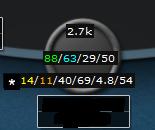Member Comments
No comments so far
 In order to survive in today's tough online games, you'll need to deal with three-betting. Luckily, your Heads-Up Display (HUD) can be a big help. Three-betting light, or re-raising pre-flop without a big hand, is such a powerful play in No Limit cash games that you need to understand how to do it to beat most games. Even in smaller games, you will want to know how strong your opponent is when they re-raise you. Without that knowledge, they may walk all over you.
In order to survive in today's tough online games, you'll need to deal with three-betting. Luckily, your Heads-Up Display (HUD) can be a big help. Three-betting light, or re-raising pre-flop without a big hand, is such a powerful play in No Limit cash games that you need to understand how to do it to beat most games. Even in smaller games, you will want to know how strong your opponent is when they re-raise you. Without that knowledge, they may walk all over you.
The three-bet stat, or 3b, will tell you how often your opponents are three-betting. Once you have a few hundred hands, this information will be accurate enough to influence your decisions. If you have fewer than 100 hands on an opponent, you can't be sure of the 3b stat, while anything over 1,000 hands is a large enough sample size to be certain that your opponent's 3b stat is accurate to within 2%.
The generally assumed correct range for 3b is quite wide and there is some debate over it. Aggressive players who enjoy three-betting light can be as high as 7% and still come out ahead, although anything over 6% requires picking your spots very carefully. If you see a player higher than 6%, then you know they are three-betting too often and you can come over the top with a four-bet or an all-in push without a monster. Good hands for this include Ace-King and middle pairs like T-T and 9-9.
A 3b stat below 3% is much too tight and anyone who is below 4% has a big hand whenever they re-raise. Against these players, you may want to throw that ace-king or pair of nines in the muck if the three-bet is too large to call to try and hit a big flop with your mediocre hand.
The second stat involving three-betting is Fold to Three Bet, or f3b. This number requires a large sample size, but once you have a few thousand hands on an opponent, especially one with a high PFR number, you can make some real money. How? By exploiting any weakness in their game by three-betting those who fold too much and never three-betting without a big hand against those who tend to defend their pre-flop raises.
The f3b stat is very dependent on your opponent's PFR stat. A player with a high PFR should be folding to re-raises more often because they are more often facing the re-raise without a big hand. Players with low PFR numbers generally have much stronger hands when they raise and therefore should be able to call or re-raise a three-bettor more often. A player with an f3b of less than 50% is defending his pre-flop raises too much. You shouldn't three-bet him light because he will usually call, but when you actually have a hand, you are likely to win a large pot from this player.
Often, you will run into opponents with an f3b of over 75%. These players are just begging you to steal from them. There isn't room in this article for an entire treatise on three-betting, but here is some quick math that explains why three-betting can be so profitable against these players.
If you are playing $1/2 and the button raises to $6, there is now $9 in the pot. If you are in the big blind, you know that no other players can re-raise behind you, which is helpful when three-betting light. If there are many of players left to act, you will run into a big hand too often. From the big blind, you can re-raise to $18, effectively putting in $16 to win $9, not usually a good bet. But if your opponent will fold 70% of the time, you will win $9 * 0.7 = $6.30 on average from the fold equity portion of the play.
The negative side of the play is that you will lose the $16 around 30% of the time. That means you lose $16 * 0.3 = $4.80. Even if you were to fold every flop when your opponent called the three-bet, you would make a profit of $6.30 - $4.80 = $1.50. That’s a buck and a half just for re-raising with nothing and knowing that your opponent will often fold. What a great game!
When your opponent does not fold, he will not always four-bet, so you won't necessarily lose the entire $16 when you get called. Sometimes, you will even win a big pot because your opponent won't suspect you have a small pair, suited ace, or suited connectors and he will be surprised when you out-flop him.
Of course, the whole thing turns in to a mess when your opponent knows about three-betting light. Pretty soon, all of your chips are in the middle with jack-nine offsuit against ace-deuce. That's for another article, but it does explain some of the hands you see pros play on television, doesn't it?
Check out our articles interpreting Pre-Flop Raise, Voluntarily Put Money into the Pot, and Aggression Factor.
No comments so far